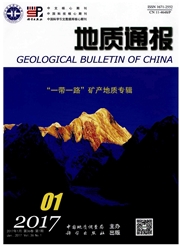

 中文摘要:
中文摘要:
玉门断裂中段地表地貌陡坎明显,主断裂直接出露地表,使前新生代地层或旱新生代地层与晚新生代松散沉积物呈断裂接触.说明玉门断裂中段形成早、活动时间长、位移幅度大,从而在冰沟口一带形成宽度超过200m的巨大破碎带。玉门断裂西段新构造活动表现的最大特点是地表较少见及主断裂的出露,以隐伏断裂为主。在地表常见有由新近系地层组成的不对称褶皱构造.属于与逆冲断裂密切相关的、也是正在变形的“活动背斜”。这说明玉门活动断裂西段形成时间较晚、活动时间短、活动位移幅度比较小。玉门断裂的活动性质以粘滑变形为主,次为蠕滑变形。玉门断裂是全新世活动断裂,最近2次新构造活动发生在距今7.4ka和3.2ka的全新世中期和晚期。该断裂也是现代发震断裂,,其西端深部的扩展破裂引发2002年的5.9级玉门地震。
 英文摘要:
英文摘要:
There is a distinct steep morphologic steep slope in the central segment of the Yumen fault, where the principal fault is direcdy exposed at the surface, making pre-Cenozoic or Early Cenozoic strata in fault contact with Late Cenozoic loose sediments. This indicates that the central segment of the Yumen fault formed earlier, was active for a longer time and has a larger displacement amount, thus forming a giant fracture zone 〉200 m wide in the Binggoukou area. The main features of neotectonic activity in the western segment of the Yumen fault is that the principal fault is seldom exposed at the surface and in the main hidden. At the surface the asymmetric folds (Laojunmiao anticline) made up of Neogene strata are usually seen at the surface, belonging to a deformed "active anticline" closely related to the thrust fault. This suggests that the western segment of the fault formed later, was active for a shorter time and has a smaller displacement amount. Characteristically, the fault moves mainly by means of stick-slip deformation and less commonly by creep deformation. As a Holocen active one, the fault experienced tow neotectonic movements in the middle and late Holocene, i.e. at -7.4 and -3.2 ka BP respectively. The fault is also an earthquake structure presently, and its propagation and rupture at depth at the western end caused the Ms 5.9 Yumen earthquake in 2002.
 同期刊论文项目
同期刊论文项目
 同项目期刊论文
同项目期刊论文
 期刊信息
期刊信息
